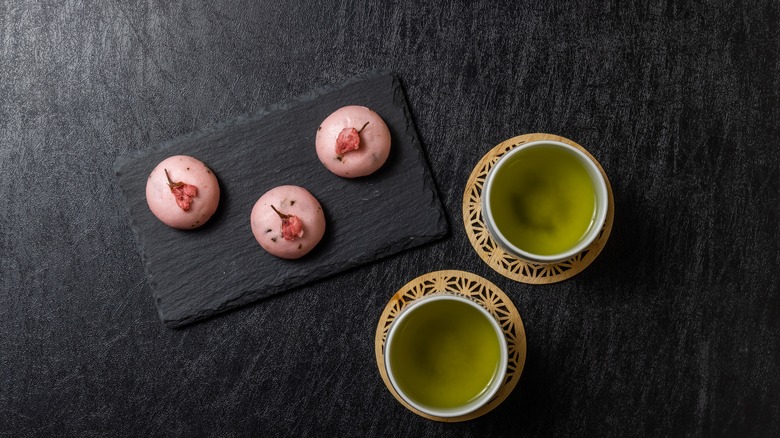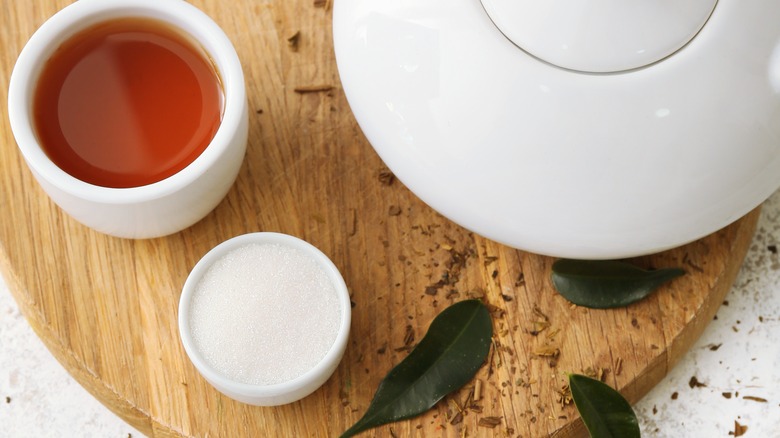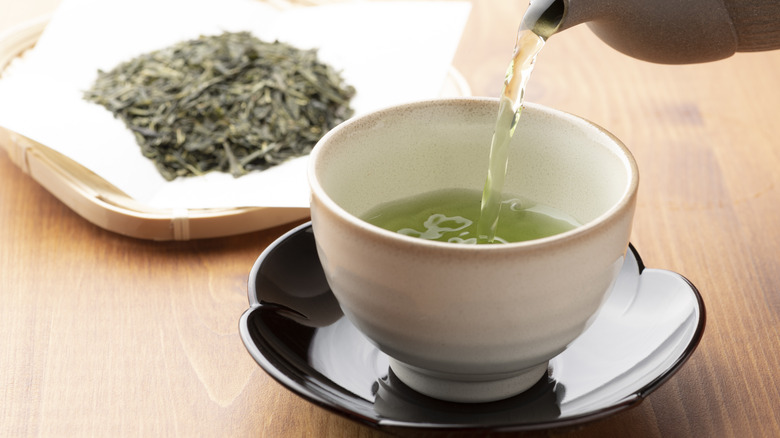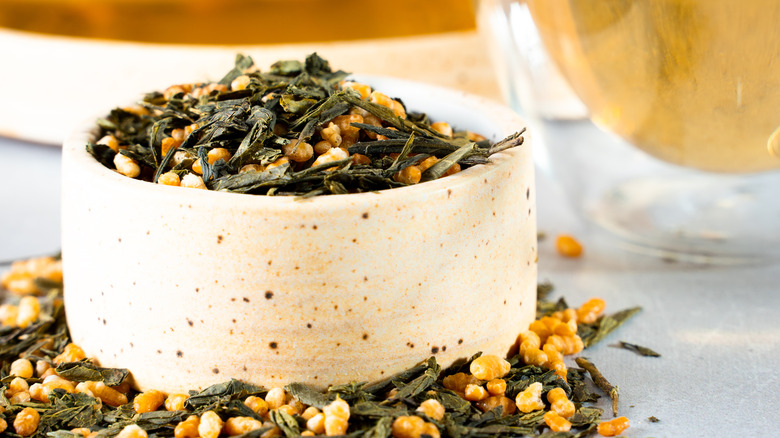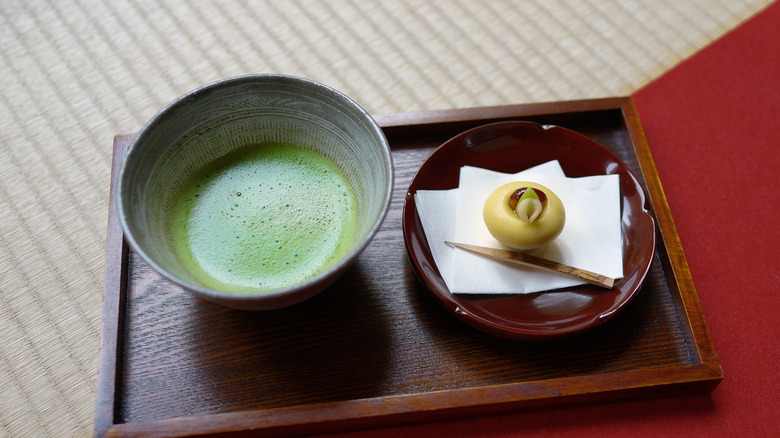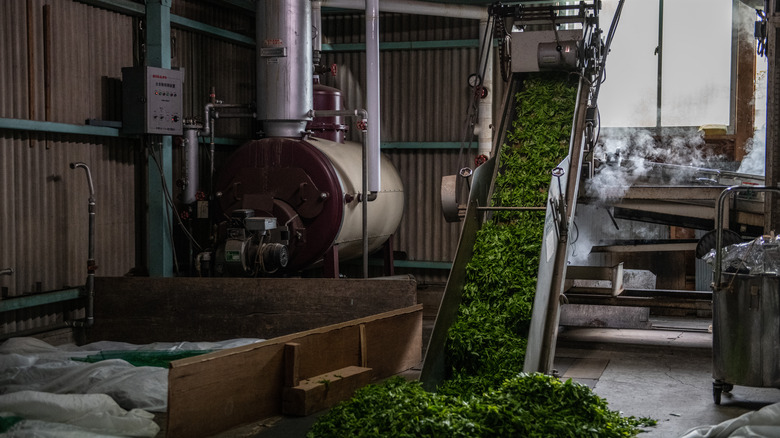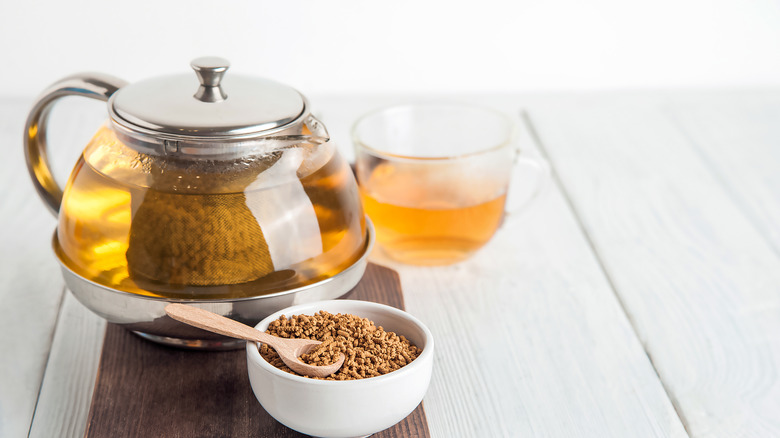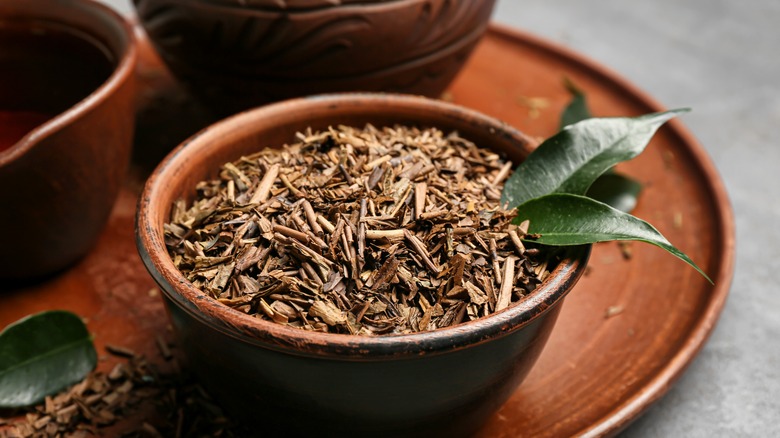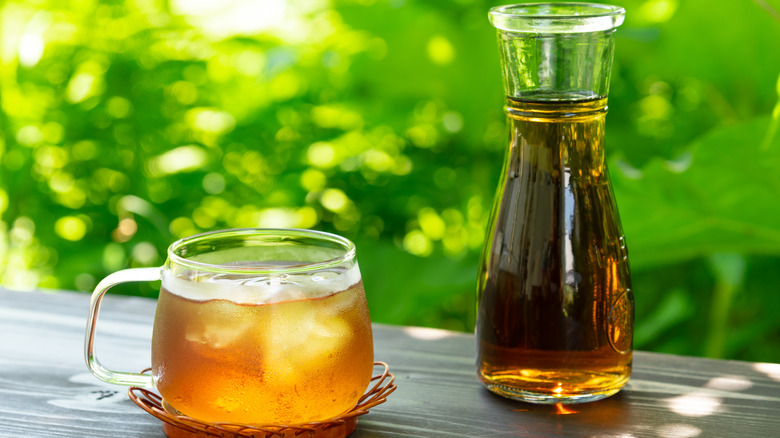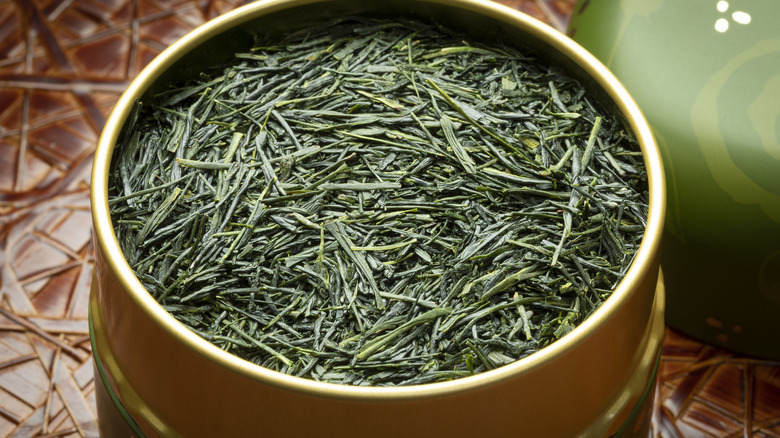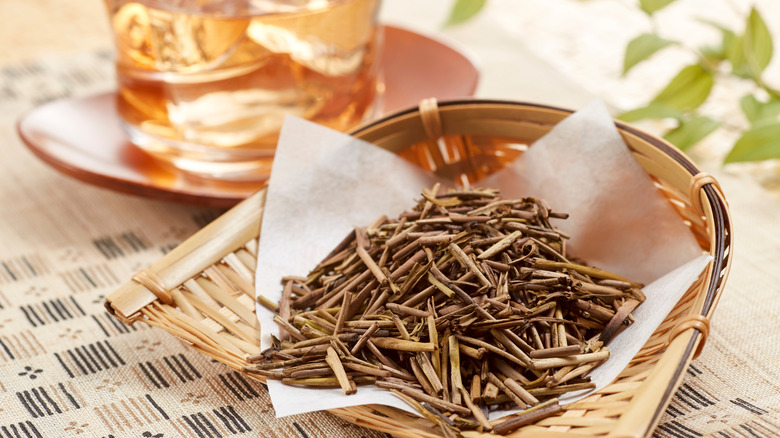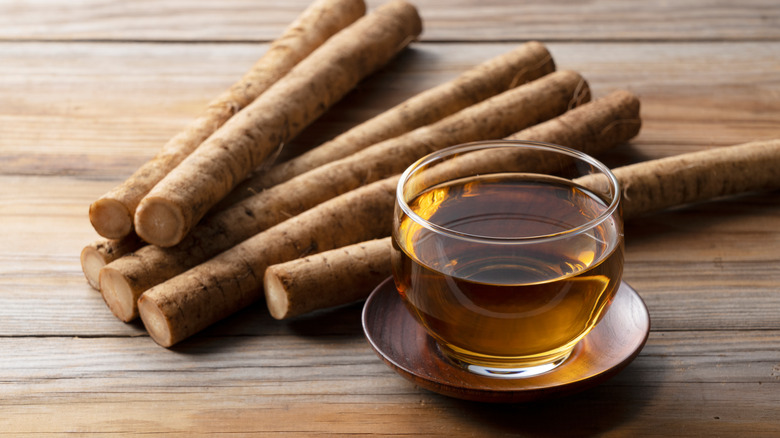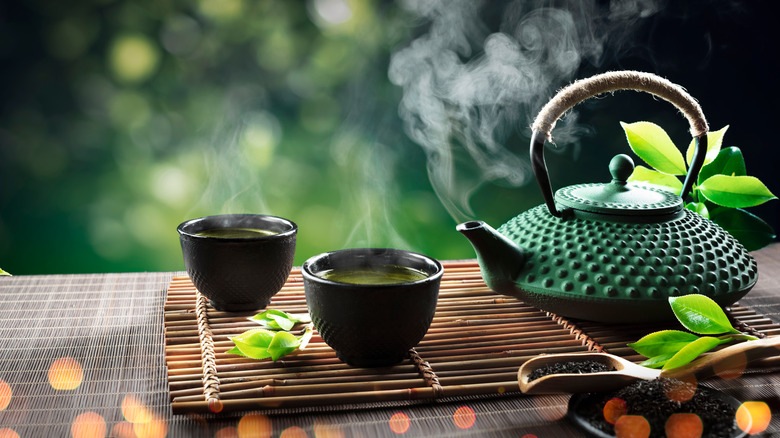12 Types Of Japanese Tea, Explained
There are countless varieties of tea in the world for you to indulge in. There is oolong, pu'er tea, tulsi rose, and even raspberry leaf tea. All of these options will make you a comforting, warm cup of tea that serves as a great way to soothe any anxiety or stress. In Japan, there are many such types of tea that can be used for any situation. Whether you are looking for a staple nighttime beverage or a special occasion premium tea, there is a fantastic option for you waiting.
When looking for Japanese tea, keep an eye out for the cha ending. Cha means tea in Japanese, and it is from this root that we get favorites like matcha, genmaicha, and hojicha. Besides that name, there are some other characteristics that many Japanese teas share. For starters, all of the caffeinated teas on this list are made from Camellia sinensis, the variety of tea plant that is responsible for almost all of the tea produced in the world. In Japan, tea can only grow successfully in warmer areas, therefore, the major tea-producing regions of Japan are in the south such as Shizuoka, Kumamoto, and Fukuoka. When you read over this list, make sure to note all of the subtle differences between each of these types of teas and enjoy the creativity that is involved in tea making.
Hojicha
Hojicha is quickly becoming a cafe staple, and for a good reason. This roasted green tea has a beautiful nuttiness that comes from the roasting process, and also delivers caffeine and the signature grassiness of green tea that we all love. Unlike other types of green tea that are just steamed and dried, hojicha is made by roasting tea leaves and stems in a clay pot over a fire. The roasting process turns the leaves and stems a dark brown color, and helps reduce the tannins in the tea. This roasting also draws out a lot of the earthy, savory flavors in the tea making hojicha rich, caramelly, and nutty.
Hojicha differs from other roasted teas because it is first steamed to stop the oxidation process and then roasted purely for flavor. If you like green tea, then adding hojicha to your repertoire is a must. This roasted tea is filled with irresistible savory notes and the comforting creaminess from the roasted leaves. It pairs well with small, buttery desserts like shortbread or poundcake, and also compliments the natural sweetness of milk in a delicious way. This combo is what makes hojicha lattes so irresistible and partly explains why they are becoming so popular so quickly. If you are looking for a way to spice up your next tea cake, try swapping hojicha into the batter and enjoy the lovely flavor that blossoms.
Sencha
Before the process of making and preserving sencha tea was discovered, matcha and bancha teas were the most common among Japanese people. However, once sencha rose in popularity, this tea variety quickly became one of the most popular types of tea across Japan. This is understandable, considering that the matcha-making process is often fairly labor intensive, and bancha does not offer the same complexity of flavor that sencha does. We will explain more about bancha and matcha in just a moment.
Sencha tea is made by steaming tea leaves to stop the oxidation process. They are then rolled into tight rolls and dried for preservation. This way of preparing sencha tea was developed by a farmer named Nagatani Soen, who delighted in the fact that by rolling and drying the tea leaves, you could preserve their rich flavor until you are ready to enjoy them. Today, sencha tea is mostly produced in the south of Japan and can be found in a variety of types depending on how much shade the plants are provided prior to harvest. Generally, the more shade a plant gets, the less bitter its leaves will be, which explains why another type of Japanese tea, gyokuro, is so popular.
Genmaicha
Genmaicha shares some similarities with hojicha in both flavor and preparation, but with essential differences. This tea is also roasted, but rather than the roasted element being the leaves and stems, genmaicha consists of green tea mixed with toasted rice kernels. Genmaicha is often called popcorn tea because you can hear the toasted kernels crackling when you pour in your hot water. The kernels are roasted and slightly popped until the warm flavor of the rice shines through and makes them irresistibly savory and delicious.
Genmaicha tea is specifically made with roasted brown rice kernels, and when toasted, these kernels of rice become slightly nutty, caramelized, and rice in flavor. Mixing in the toasted rice also makes genmaicha the perfect bedtime tea because the warm taste of the rice is soothing for your mind and taste buds. The rice component also makes genmaicha one of the least caffeinated Japanese green teas available. On top of that, the toasted rice dilutes the tea leaves in a way, making genmaicha a cheaper option, but one that is absolutely delectable.
Matcha
Matcha, undoubtedly the most famous tea on this list worldwide, is a powdered version of green tea that must be whisked very quickly with a bamboo whisk, or chasen, to be incorporated and absorbed into hot water. The foamy, light green tea that results from the rapid whisking is high in caffeine, fairly bitter, and pairs indescribably well with wagashi sweets. In the Japanese art of tea ceremony, matcha plays an essential role. This makes matcha more than just a delicious drink. It is also deeply culturally important to Japan and traditional forms of Japanese art.
Matcha also pairs well with dairy, which explains why matcha lattes, ice cream, and confectionaries of all kinds have stolen the tea's spotlight. Matcha can be found in many different forms with varying labels. For example, you may encounter ceremonial grade versus culinary grade matcha, which is fairly self-explanatory. Culinary matcha should be used to flavor your matcha cookies, mochi muffins, and cakes, while ceremonial grade matcha, which is often much more expensive, should be reserved for proper matcha tea-making.
Shincha
Shin, meaning new, and cha meaning tea, refers to tea made from new tea leaves. Each year, after a long winter, the tea plants begin to produce again, and the first leaves that sprout and are harvested will be turned into shincha. Shincha tea is light in flavor and exceptionally bright, making it a well-sought-after tea that marks a new spring and tea season. Once you taste shincha, you will understand what all of the fuss is about. The bright greenness of this tea still qualifies it as a green tea, but with all of the vibrancy of a fresh sprout.
Once the young leaves are harvested, they are steamed, rolled, and dried for storage. However, if these young leaves are left on the plant to fully mature, shincha tea leaves would become sencha, and therefore the final tea would be less tender, sweet, and grassy. The reason shincha is so coveted is that the harvest window for shincha only lasts for a couple of days out of the year, meaning that the quantity is very limited. This limited quantity is also a huge reason that shincha is so sought after and prized. Each year people from all around the world pre-order their shincha to ensure that their stash will be well-stocked for the coming months. If you want to get on a shincha ordering list, you have to act fast because many times the product is sold-out even before it is harvested.
Sobacha
Perhaps you have heard of soba in regard to the noodles. Soba noodles, which are square in shape, and have a delightful nuttiness that pairs well with their dark-brown, almost grey color, are made from buckwheat. In Japanese, soba translates to buckwheat. Can you see where this is going? What do soba noodles and sobacha have in common? Well, they are both made from buckwheat. Buckwheat is a naturally gluten-free grain that makes baked items and other things, like noodles, a very dark grey color. But if you can get past that, buckwheat has a deep richness and density that makes it wonderfully comforting to eat.
Sobacha, or buckwheat tea, is made from roasted and dried buckwheat that can then be brewed like any other tea. Like mugicha, it also tastes delicious when iced and serves as a wonderfully refreshing and satisfying drink. Sobacha derives its satisfying flavor from the roasted buckwheat which gives off a very nutty flavor and aroma when roasted and then steeped. This makes sobacha the ideal tea for a cold evening, or right before bed. Since it is made from buckwheat, another point for sobacha is that it is not caffeinated, making it a great everyday drink to stay hydrated and happy.
Kukicha
Kukicha is very similar to sencha, but it does have some key differences that make its flavor and color unique. To start, kukicha is made from tea leaves that are similarly processed to sencha, but, mixed with stems and stalks from the tea plant. This makes kukicha colorful in terms of the color gradient, and more flavorful and complex. Unlike hojicha, which also uses the stems of plants, kukicha does not roast the whole tea mix. This makes the resulting kukicha much fresher in flavor and less nutty like hojicha.
In fact, kukicha tastes like sencha, but with less bitterness. Rather, kukicha is often described as having a strong umami flavor, which may be attributed to the stems which are included in the mix. The stems release amino acids and are also high in theanine, which is a naturally-occurring amino acid that helps with anxiety and being calm (via TeaLife). When going to buy kukicha, it is recommended that you try to find some labeled "karigane". Karigane kukicha uses stems and cuttings from the highest quality tea plants, resulting in a kukicha that is especially fresh, bright, and flavorful.
Mugicha
If sobacha makes a good summer iced drink, mugicha certainly qualifies as an excellent summer iced drink. This scrumptious tea, which is made from roasted barley, has all of the nuttiness and earthiness that is loved in roasted teas. On top of that, mugicha tea can be made in very large quantities and left to sit in your fridge as the perfect beverage to get you through the summer. The only hard part is waiting for your big vat of mugicha to cool completely. But don't worry, if you have to sneak a mug full while it is hot, you will still be pleasantly surprised. With similar teas in both China and Korea, mugicha can be found in many local grocery stores or online. Regardless of where you buy your mugicha, it is certainly worth the effort of finding it.
Mugicha gets its signature deliciousness from the roasted barley it is made from. To prepare the barley for tea, it must first be de-hulled, then roasted to a soft caramel color to draw out the flavor of the grains. Mugicha is somewhat of an acquired taste for some, and while nothing compares to the childhood nostalgia of drinking mugicha all summer, this tea has some happy converts thanks to its wonderful health benefits. Mugicha helps your digestion and skin health, and most importantly, it can keep you hydrated during hot, humid summers.
Gyokuro
Gyokuro is a specialty premium tea that is known for its deeply rich, green color, and unique taste. This color and taste come from the specific way that gyokuro is processed, which includes a long period of shade coverage. This shade is artificially imposed on the plants through the process of covering them with a heavy, custom-made tarp that blocks out the sun.
But why cover the plants? Good question. Covering the tea plants allows for the caffeine levels to rise, and also darkens the leaves. These darker leaves give gyokuro its signature dark green color. Gyokuro, with its long shade time and highly caffeinated leaves, is also naturally sweet.
Now that you know about gyokuro, you may wonder how this process came to be. It was discovered by a tea farmer who observed that the families who covered their tea plants to protect them from the cold, bore teas that were smoother, richer, and more flavorful. Fast forward a couple of hundred years, and we have gyokuro.
Bancha
One of the cheaper, more economical everyday tea choices, bancha is nothing special. It is special in that it is a variety of tea that has been hand harvested and rolled, but beyond that, bancha is defined as using the largest, least desirable tea leaves. During tea harvest, the small and medium-sized leaves are usually saved for sencha and gyokuro, while the larger, more fibrous leaves are used for bancha. Using these tougher, older leaves, makes bancha less coveted and refined. However, the simpler flavor profile of bancha also makes it much more affordable, especially for people who regularly drink green tea. Therefore, if you want a tea you can enjoy daily, bancha might be your option.
When looking at a bancha leaf compared to a sencha leaf, you can see that the bancha leaf struggles to roll into a thin point due to its tougher fibers. Larger tea leaves are also lower in amino acids and caffeine. Therefore, bancha tends to have a less complex flavor. However, this is not to dissuade you from drinking bancha — it's quite the opposite. Bancha is a great option when you are deciding on a casual tea to have in your pantry. It has the classic green tea flavor that we love, just minus some layered nuances. Regardless, it still offers a very satisfying and warming tea experience, minus the cost of a very high-quality tea.
Gobocha
Gobocha is another example of a tea that is not technically a tea, and should rather be described as an infusion or herbal tea. However, if we ignore this slight technicality, we can focus on how delightfully yummy gobocha is. Gobo, meaning burdock root, is a type of root vegetable that is long. And we mean very, very long. Fresh gobo is usually at least 2 feet long, but only about 1 inch wide at its base, making this vegetable long, floppy, and silly looking. When you find gobo in the store, make sure to get the firmest, stiffest piece. This vegetable cannot stay fresh for very long and must be processed quickly to prevent aging and oxidation.
If you can get past the whimsical look of the gobo, you can begin to appreciate how good it tastes. Gobo has a very distinctive earthy flavor that goes well with other root vegetables, is exceptional in stews, and pairs well with flavorful oils like sesame oil. It is also very fibrous and boasts high levels of dietary fiber.
Gobocha, which is made from small shavings of pieces of dried gobo, has gobo's wonderful earthiness and some additional layers of sweetness that balance with the deep flavor of the gobo. On top of that, gobocha is not caffeinated, making it a great option for later in the evening if you are caffeine sensitive.
Tamaryokucha
This tea is very similar in process to sencha, with a crucial difference being their drying process. Another green tea, tamaryokucha is most commonly produced in Kyushu, one of the southern islands in Japan. In Kyushu, the weather tends to be more temperate and well-suited for tea growing. Tamaryokucha is made, like sencha, by steaming and pan-roasting the leaves. However, while sencha is then rolled into tight, toothpick-like shapes, tamaryokucha is placed in a drum-shaped tumbler to be dried. Here, the leaves are blown on with hot air, and while rotating, the leaves curl around themselves into tight balls.
In the past, Japan had a ban on pan-roasting teas, requiring all teas to be steamed and then dried rather than pan-fired. Therefore, it was not until the 1950s that tamaryokucha was developed. Tamaryokucha came into existence in part because, at the time, the Russian and SWANA tea markets had a high demand for Chinese teas. While the Japanese government forbade the production of pan-fired tea, the special way of drying tamaryokucha made it comparable to Chinese teas, and popular across Russia and the SWANA region.
